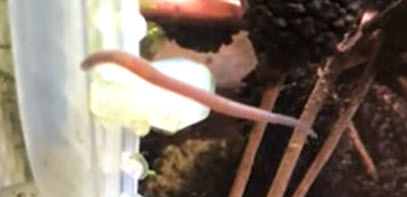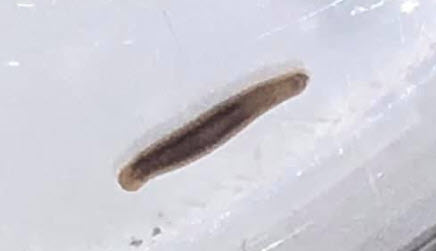Leeches are interesting little critters sometimes seen in aquariums. They are annelid worms or "tubeworms" closely related to good old earthworms. There are several varieties seen in aquariums. The most common are snail leeches and Asian leeches.
They all have a round body which typically remains motionless and a thinner head that waves about hunting for food. Most move by “inching” along, head attaches, tail moves, tail attaches, head moves etc. Their bodies can typically stretch out quite long and then contract rapidly. These long stretched out bodies look very much like a “worm” and can be white, gray or brown.
Snail leeches
“Snail leeches” are common in aquariums. The typical snail leech attaches to an organism like a snail and drinks its blood. If there are snails in the aquarium and those snails seem to be dying at an alarming rate suspect snail leeches. They can drain a snail dry in a few days.
Most of them look like translucent white or brown (sometimes even green!) worms with a teardrop shape. In an aquarium the thicker half of their bodies remain firmly in place on the glass or substrate while the thinner head portion waves about. There have been videos on social media of the floor of snail aquariums literally covered with small waving snail leeches. Talk about gross! Shrimp eat these denizens.
This is a photo of a typical snail leech. Note the thick body and the narrow tapering head:

Snail-leeches can be pretty easily identified by their build – which is drop-shaped. Often, eggs and the digestive tract can be seen in the middle of the body, which makes them easily distinguishable from planarian flatworms. From species to species, snail-leeches vary in color, reddish-brown, green and also creamy-white colors are possible. They can reach a length of up to three centimeters. Mostly they live hidden in the substrate or holding onto stones or plant leaves.
Snail-leeches live predatory off worms and snails, which are unceremoniously sucked dry. These leeches are unsurprisingly VERY unwelcome guests in aquariums containing more special snails like Tylomelania sp. Fortunately, they do not occur in larger groups, but are more likely to pop up as individuals.
The movement of the snail-leech resembles that of a caterpillar. First, the rear end is held on the ground by a suction cup, then the leech pushes its front end forward. Next, the suction cup at the front end attaches to the ground and the tail end follows. This mode of movement is quite different from planarians and other aquatic worms. Furthermore, snail-leeches are skillful swimmers – much unlike planatian flatworms -, moving surprisingly fast through the water in s-shapes. A snail-leech’s body doesn’t feel soft and slimy, but hard and gristly.
Per Aquascaping wiki:

Other species of snail leeches can also present as typical very small brown or black leeches attached to the snails. It takes a good eye to see these tiny critters.
Since snail leeches can suck a snail or shrimp dry it is important to get rid of snail leeches in aquariums with snails or shrimp. Unfortunately that is not easy. All the medications (Fenbendazole and copper) which kill snail leeches also kill snails. Fenbendazole in the water normally doesn’t kill shrimp but kills some types of snails. Sometimes the best course is to remove all snails from the tank to another tank, then treat the infected aquarium for two months. Then put the snails back in.
Asian Leech
Another denizen commonly seen is the common freshwater Asian leech Barbronia weberi. This looks like an earthworm with a slightly slimmer head. Only one half of the body remains motionless while the other half of the body, the head, waves about. Similar to an inchworm, the leech makes steps as it progresses with the help of the suction cups at its front and rear end. This is a picture on such a leech.

The Asian freshwater leech, Barbronia weberi, are typical freshwater leeches that feed on invertebrates (e.g. worms, snails and shrimp) (Govedich et al. 2002, 2003; Neubert and Nesemann 1999; Pavluk et al. 2011; Reed 2001). They are a real problem in shrimp tanks. They have stylets around their mouths which allow them to attach to crustaceans such a shrimp and suck the crustaceans dry.
There are several references on Google which say this leech does not eat shrimp but rather only feeds on small detritus worms. From Aquascaping wiki:
“Even though Barbronia weberi is a predatory leech, small worms and ground-dwelling microorganisms are on its menu. There is no danger for your fish, shrimp and snails.”
Do not believe everything you read in Google. From personal experience I can tell you this leech sucks adult shrimp dry and leaves their carcasses around a shrimp tank. I have had them wipe out the shrimp in a tank.

There have been several hobbyists on social media who have asked how to to eradicate the “dugesia planaria” which is wiping out their shrimp. They have posted a photo or a video of the “planaria”. In all cases the “planaria” was actually a brown leech. It would appear that this leech is not well studied as to its effects in the shrimp aquarium and is very underestimated by the shrimp keeping hobby.

And I can tell you they are very difficult to eradicate. You need to treat the water with fenbendazole for months, which can get expensive.

There are many who look at expanding and contracting brown leeches and mistake them for planaria. Planaria do NOT expand and contract nor do they move even moderately fast. This type of brown leech often swims through the water in a sinuous fluid movement of “S” shapes.
Larger Leeches
There are hundreds of species of leeches of all sizes and colors. Sometimes one will find white leeches of a pretty decent size in the aquarium. These have typically hitch hiked in on a plant and won’t reproduce in the aquarium.

Fish Leeches
Very rarely there will be long thin worm-like fish leeches introduced into the aquarium, typically from live blackworms, bloodworms or tubifex worms. These can multiply and kill fish. This is a very real problem which is only cured with copper or fenbendazole.

“Detritus Worm” Leeches
There are a lot of types of small white “worms” seen in aquarium substrates. These little white worms are called “detritus worms” because they all live in the detritus. Most detritus “worms” are annelid worms (tubeworms). There are two types of annelid worms. The most common type by far looks and moves just like a tiny very thin white earthworm. These are the “detritus worms” commonly found writhing and waving about in the water column.
But rarely some of these worms will be a little thicker than the “normal” detritus worm and move by “inching” over the substrate. The front part of the “worm” will attach itself and pull up the back part. Then the back part will attach itself and push forward the front part of the “worm”. These “worms” are actually leeches (another type of annelid or tubeworm). They feed on other worms and critters in the substrate.
These small leeches can be a problem in shrimp aquariums where they can kill baby shrimp. And sometimes these small leeches are the immature versions of large leeches like the Asian leech, which can eat adult shrimp.

Other Leeches
There is one species of leech that has a very small head on a long and narrow two to three centimeter worm like white body that moves like a planaria, in a slow gliding motion. One has to look for a small head which waves back and forth to identify it. We have been unable to find a clear identity on this leech. But there have been two videos of them posted on social media.
Controlling Leeches
All leeches and snail leeches CAN sometimes be killed by fenbendazole or copper. Dog de-wormer (fenbendazole powder) needs to be administered at a 0.7 grams per 100 gallons level (2 ppm) at one dose every week for three weeks then one dose every month for three months. The leech eggs can take up to 36 days to hatch. Mix the powder into a bottle half filled with water and then vigorously shake the bottle to break up all the lumps.
The fenbendazole is typically purchased as a dog dewormer called Panacur C. This is the dosing needed for leeches:

| Type of Pest/Phylum | Examples of this Phylum | Selective medications | Non-Selective Medications |
|---|---|---|---|
| Roundworms Nematoda | Camallanus Capillaria | Levamisole only in food | Fenbendazole only in Food |
| Flatworms | Planaria and Rhabdocoelas | Prziquantel, No Planaria | Fenbendazole, Copper |
| Tubeworms Annelida | Detritus worms Leeches Snail Leaaches | None | Fenbendazole, Copper |
| Polyps Cnidaria | Hydra | None | Fenbendazole, Copper |
| Gastropods | Snails | None | Fenbendazole, Copper |
| Crustaceans | Shrimp | None | Copper |
Obviously if one has an infestation of snail leeches in a snail aquarium the options are limited. Note that the cautions about deaths of snails, shrimp and invertebrates is very dose dependent. Copper and Fenbendazole are often used with no snail deaths because the dosage isn’t high enough. Conversely using a high dosage of fenbendazole can possibly kill shrimp. But copper WILL kill shrimp at any reasonable dosage.
If one has leeches in a tank with only fish and the GH of the tank is greater than 3, then copper becomes the treatment of choice as it is a lot cheaper.
Some of the commercial copper medications which work include Seachem Cupramine, Copper Power, Copper Aide or Copper Safe. If one can’t get these medications one can get copper sulfate as “blue vitriol” in the drain cleaner section of the hardware store. Use the commercial ich medications at a dosage recommended for ich.

Copper has what is called limited selectivity. Copper medication kills invertebrates (ich, costia, velvet, etc.), it has much less of an effect on fish. It is recommended not to use copper in any aquarium which has shrimp, snails, or crayfish.
Copper sulfate, CuSO₄, treats leeches at a rate calculated by dividing the water’s alkalinity (KH) by 100 and using that concentration in ppm for the copper sulfate treatment. For example, aquarium water with a KH alkalinity of 80 ppm (dKH of 4.4 or 80/18) would need 0.8 ppm (80/100 x 1 ppm) copper sulfate (CuSO₄). If the alkalinity is measured by dKH (typically a number between 1 and 20) the alkalinity needs to be multiplied by 18 before doing the calculation.
This is a very small amount of copper sulfate. In a 100-gallon aquarium one part per million (1 ppm) is 0.38 grams. A typical 100-gallon aquarium with an alkalinity of 80 ppm or a KH of 80 (4.4 dKH) would only need 0.3 grams (0.38 x 0.8 = 0.3 grams) of copper sulfate. A twenty gallon would need only 0.06 grams.
It is typically not recommended to use ANY amount of copper when the water is below 70 KH, or 3 dKH or lower.
It is important to keep up the therapeutic level of the copper for a considerable length of time. Treat once a week for three weeks then once a month for three months. Do a 75% water change before each treatment to remove residual copper and prevent an overdose.
Asian leeches can be controlled by planaria traps. Actually most of the photos of planaria traps on the web show leeches inside them, not planaria. LOL

For more information on all the various pests found in the aquarium click on the following link:


